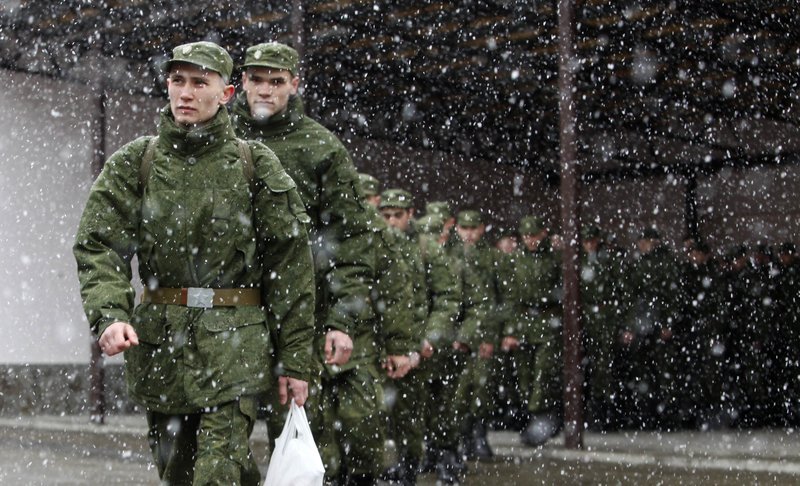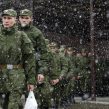
Mission Impossible: Russia’s Low-Tech-High-Tech Army
Publication: Eurasia Daily Monitor Volume: 8 Issue: 148
By:

Russian military manning, saddled with conscripts serving for twelve months and reduced numbers of contract personnel, continues to be subject to experiments. The latest, relates to a brigade in the North Caucasus, which will witness the preparation of “combat-ready” conscripts in a new training program lasting 90 days. Vladimir Mukhin noted that the brigade should be staffed by 70 percent contract personnel, based on official reporting, but it was becoming more reliant on conscripts, reflecting issues impacting on combat readiness throughout the Russian Ground Forces. The article ended by questioning what level of “combat-readiness” could be achieved by introducing these conscripts into active service even after an intensified three-month course. Colonel-General Yuriy Bukreyev, former Chief of the Ground Forces, lamented that the defense ministry has still not created the conditions needed to attract sufficient numbers of Kontraktniki in the armed forces (Nezavisimoye Voyennoye Obozreniye, July 28).
Even the advocates of conscription cannot defend masquerading fast-tracked combat ready conscripts, but the deception for public consumption persists. Officially, conscripts should not serve in “hotspots” but local representatives of the Union of Soldiers’ Mothers receive with ever increasing frequency complaints that their sons are drafted into units in the North Caucasus. In 2007, the defense ministry rapidly created two elite mountain warfare brigades based in the North Caucasus: the 33rd Motorized Rifle Brigade (MRB) in Botlikh, Dagestan and the 34th MRB in Zelenchukskaya, Karachay-Cherkessia, tasked with reinforcing Russia’s southern borders (EDM, July 19).
One of the officers in the 34th MRB told Nezavisimaya Gazeta: “You know, our brigade, just like the Botlikh formation, is a middle finger to those who still hope to repeat something like the Chechen war in the Caucasus. They will try to come from outside and group together inside the country, but they do not have a single chance to initiate any more or less significant combat action. They will be blocked and destroyed by our brigade immediately.” However, Oleg Vladykin highlighted the half-hearted effort by the brigade commander, Major-General Artur Shemaytis, to convince his men that all is well, saying: “We are military people. The objective was imposed on us and we will achieve it without fail.” Vladykin concluded that the elite formation could “block” an enemy, but do little else (Nezavisimoye Voyennoye Obozreniye, June 28).
Mukhin also reported on the slow progress in introducing automated command and control systems as part of the modernization of the Russian armed forces. The Unified System for Command and Control at the Tactical Level (Yedinaya avtomatizirovannaya sistema upravleniya takticheskim zvenom –YeSU TZ) is a vital element in developing network-centric warfare capabilities. Mukhin suggest the source of the problem lies at the government level. On July 28 Military Industrial-Commission First Deputy Chairman, Yuriy Borisov, led a discussion on these setbacks at the showcase 5th MRB in Alabino, Moscow Region. Earlier in July, the defense ministry attempted to convince journalists that rapid progress was being made towards implementing network-centric approaches to warfare. However, officers in the 5th MRB stated off-the-record, that journalists were only shown an engagement being rehearsed that had been refined at Mulino last fall. Grusha unmanned aerial vehicles (UAVs) featured, along with existing Eleron-2 and Strekoza UAVs, though the defense ministry is not procuring these for the armed forces, despite their presence in non-defense ministry forces (Nezavisimoye Voyennoye Obozreniye, July 20).
Defense industry officials claim the defense ministry rejected the idea of creating a scientific research center located in the Combined-Arms Academy to be involved in developing elements of the YeSU TZ. “The absence of a systematic theoretical foundation for the development of the YeSU TZ could be one of the greatest shortcomings for our current Russian military science. The elements of the joint troop command and control system have already been developed, but the corresponding methodology and theory for it do not yet exist. This will hinder the introduction of new types of military equipment in the troops,” explained Colonel Eduard Rodyukov, a corresponding member of the Academy of Military Sciences. Moreover, Rodyukov recalled that Colonel Musa Khamzatov and Colonel Andrei Demidyuk were involved in developing domestic network-centric theory at the General Staff Academy. Demidyuk has been released into the reserve and Khamzatov is awaiting the same fate. Igor Korotchenko, the Editor-in-Chief of Natsionalnaya Oborona, said work on the YeSU TZ has meandered since 2000 and that it will require joint efforts by the defense ministry, the Military-Industrial Commission and the defense industry to resolve outstanding issues: “A serious scientific base, the needed resources and, of course, the desire of specialists to make a state-of-the-art command and control and weapons control system must be present. All this exists in Russia, yet no one can resolve all these problems if one has the political will” (Nezavisimoye Voyennoye Obozreniye, July 20).
While designers and defense officials appear to believe they have an indefinite timescale to realize such ambitious plans, experiments are the order of the day, even in parts of Russia facing real or potentially serious security challenges. In an article in Voyenno Promyshlennyy Kuryer, Aleksandr Khramchikhin assessed the implications of the US-NATO military drawdown in Afghanistan and the future security role that Russia might play in Central Asia. In the context of the Arab Spring, Khramchikhin asked where Russia might be able to stop the “green wave.” Examining a worst-case scenario where post-NATO Afghanistan reverts to Taliban rule, the author recognized the dire prospects of militancy spreading throughout Central Asia. Turning to assess the impact of the “new look” on Russia’s Central Military District (MD), Khramchikhin outlined the scale of the challenge. Central MD (headquarters in Yekaterinburg) also “covers” the Central Asian sector, both in the sense of likely involvement in any crisis and in terms of providing support to the Collective Security Treaty Organization (CSTO). The MD has one tank brigade, seven MRBs (one being disbanded), two missile brigades, two air defense missile brigades, one artillery brigade and one rocket-artillery brigade. It also has five bases for storage and repair of equipment, reserve tank bases in Krasnoyarsk Krai and Sverdlovsk Oblast, as well as hosting the 31st Air Assault Brigade in Ulyanovsk. Khramchikhin sketched the nature of weapons and equipment, including with reference to the air force, and considered if the Central MD could cope with a deepening crisis in Central Asia (https://vpk-news.ru/articles/7936, July 20).
Not only did he believe that reinforcement would be required from Southern MD, including the mountain brigades and that the presence of airborne units subordinated to the General Staff would likely involve operational command from Moscow rather than Yekaterinburg, he suggested that the Kremlin, faced with a long and difficult war, would abandon Uzbekistan, Kyrgyzstan and Tajikistan: “The most realistic prospect is a drawn-out anti-guerilla campaign of attrition in the mountains of Tajikistan, Kyrgyzstan, and South Uzbekistan. At the same time, the longer such a war continues (and the enemy does not have sufficient resources for such a war), the higher the probability of a conflagration in the Fergana Valley” (https://vpk-news.ru/articles/7936, July 20).
Khramchikhin’s scenario for Central Asia was undoubtedly bleak, though no one rebutted his negative assessment of Russia’s limited capabilities in Central MD or its potential to cope with counter-insurgency on a broader scale. Yet, the discussion may be occurring behind closed doors: Belarusian President, Alyaksandr Lukashenka, has placed on the CSTO agenda for a meeting on August 12 consideration of the “green wave” and the future security of Central Asia (https://www.odkb.gov.ru/start/indexnewsb.htm).




